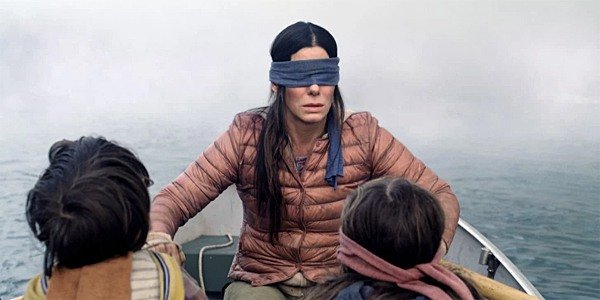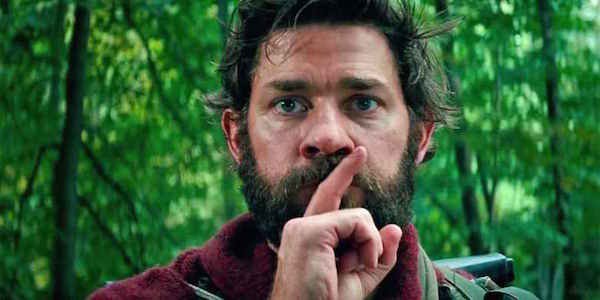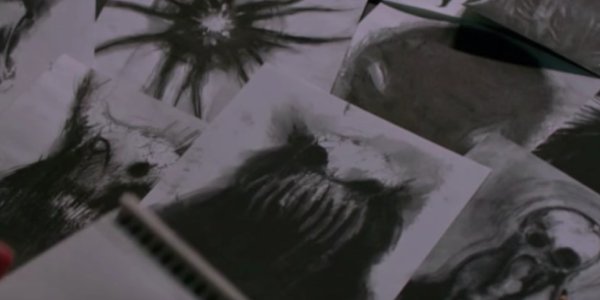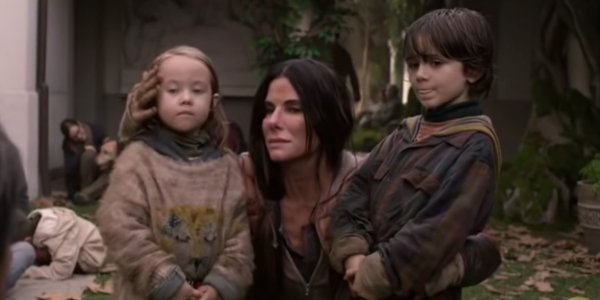Netflix's Bird Box: Explaining The Ending And The Monsters

Netflix really hit it big in December 2018 with its original film Bird Box. The thriller, starring and produced by Sandra Bullock, about an unseen, apocalyptic monster who drives people to suicide with just one look, broke records for the streamer and inspired a wave of attention on the Internet.
Whether we're talking silly memes, potentially life-threatening viral challenges, or comparisons to another sensory-minded, apocalyptic thriller with parental themes from that year, Bird Box was, positively, the viral movie event of the year. Yet, despite all of the praise and discussion the Netflix film has garnered, there is still plenty it leaves unexplained that has invoked much frustration.
We've looking into some of your most frequently asked questions regarding Sandra Bullock’s Netflix horror hit. Let’s see if we can get to the bottom of what the hell was up with Bird Box.

Was Netflix’s Bird Box Inspired By A Quiet Place?
When Bird Box first premiered on December 21, 2018, it was immediately referred to as Netflix’s A Quiet Place. It was hard for people not to see similarities between the apocalyptic thriller and John Krasinski’s theatrical horror hit about a world that falls prey to creatures that hunt by sound.
The biggest argument for this comparison was each respective film’s gimmick. In A Quiet Place, you make a sound and you die. In Bird Box, you remove your blindfold and you die.
Seems fair to call out Netflix for wanting to cash in on the commercial and critical success of A Quiet Place by developing its own survival-by-sensory-deprivation thriller, right? If you have really bought into that assumption, now might be a good time to take off your blindfold.
It may not be so simple. Bird Box is actually an adaptation of a novel by Josh Malerman, which was published in 2014. The film rights to the book were originally optioned by Universal Studios in 2013, a year before the book’s release and two years before John Krasinski was sent the first draft of the script for A Quiet Place.
Your Daily Blend of Entertainment News
So, obviously, evidence of Bird Box’s direct link to A Quiet Place cannot be proven, although the timing of both movies is interesting. In fact, it might be easier to make an argument that A Quiet Place ripped off Bird Box, but even that would be far-fetched given the clear distinction between the characters, the construction of the narrative, and the greatly differing rules of the apocalypse.
Monsters that we can see who hunt on sound and an unseen force that drives people to suicide by sight sound like two differing concepts to me, at least. In fact, I am surprised M. Night Shyamalan has not brought up Bird Box in regards to similarities to his 2008 “thriller” The Happening.
In conclusion, the Bird Box vs. A Quiet Place conundrum is likely an incidental product of proximity. John Krasinski’s film happened to still be fresh in audiences’ minds upon the release of the Netflix’s apocalyptic sensory thriller, leading viewers to draw comparisons.
However, Netflix is not completely off the hook. More than a year after the release of A Quiet Place, the streaming service dropped an original film called The Silence, based on Tom Lebbon’s novel about a world fallen prey to creatures that hunt by sound. Bird Box is looking pretty unique now, huh?

What Exactly Are The Monsters in Bird Box?
Although it seemed to frustrate many viewers, one of the most intriguing things about Bird Box is the air of suspense surrounding its main obstacle. We never see what this apocalyptic force driving people to take their own lives really is.
There are clues sprinkled all throughout Bird Box that suggest what it may be. What can we infer from these clues?
In one of the first scenes after Malorie (Sandra Bullock) and the rest of the survivors take refuge at the home of Douglas (John Malkovich), grocery store employee Charlie (Get Out’s Lil Rel Howery) explains to the group his own theories, based on research he has done for his own amateur novel. He talks about mythological creatures, believed to be the destined seeds of destruction at the end of days in various cultures.
We also get what seems to be a glimpse of the creature or creatures' appearance from sketches brought in by Gary (Tom Hollander), a stranger whose means of survival is questionable and who later turns problematic, but more on that later. So, we could assume the bad thing in Bird Box might appear to be something like an H.P. Lovecraft classic (see Cthulu).
However, that clue seems to contradict another theory that is strongly alluded to throughout Bird Box. There many key scenes in that film that suggest the “monsters” are the manifestation of your own worst fear, taking on a different appearance to each person, which drives them to suicide.
We know for sure there is a creatures, as is proven in the blind drive to the grocery store during which the physical presence of a monster set off a car’s surrounding sensory system. So, we could assume that the monster(s) are a physical manifestation of fear and that the phobia it(they) took on during that blind drive to taunt the survivors was, I don’t know, a driving safety hazard?
The thing is, there is another clue that contradicts this Bird Box theory as well. At the moment of Olympia’s (Danielle Macdonald) death, she looks out into the unknown and says, “You’re not so bad.”
If the Bird Box creatures are so traumatizing they drive humans to mercy-killing, what could possibly be “not so bad” about them? This is getting confusing. Perhaps we should ask the author.
Author Josh Malerman recounted his inspiration for Bird Box in an interview with Astral Road Media for the Midwest Literary walk in 2015. He said:
When I was, like, 13 years old, there was a teacher who mentioned that a man would go mad, lose his mind, if he were to attempt to fathom infinity… I really started thinking about and it became, like, a monstrous concept to me. So, at some point, I started to think of infinity or something the human mind can’t assimilate as a monster and what if that idea was actually, like, personified… on your front porch… and if you open the door and encounter it, you can’t assimilate [it and] you’re going to go mad.
So, despite all the clues of living nightmares and Lovecraftian beasts, according to the author, the threat in the world of Bird Box is “infinity?” Well, there you have it, folks: the true nature of the “monster" is never going to be made perfectly clear.
However, I still believe this is key to the appeal of Bird Box. Besides, it’s better than the monster reveal they almost went with.

Why Were Some People Unaffected By The Monsters In Bird Box?
In the apocalyptic world of Bird Box, humans must keep their eyes shielded at all times as to avoid certain death. However, it is revealed that not all humans are affected this way.
Probably the more dangerous obstacle that Malorie (Sandra Bullock) faces when traveling with Girl (Vivien Lyra Blair) and Boy (Julian Edwards) are the fellow humans who proudly keep their eyes uncovered. Like a cult of worshippers treating the unseen force as a deity, they beg other survivors to remove their blindfolds and bask in the beauty of the unseen.
The question is, what is their fascination with the Bird Box monsters and how are they still alive? What makes them so special?
The most popular theory, and the one most clearly suggested in Bird Box, is that the “worshippers” were people of poor mental health to begin with, cancelling out the madness-inducing effect the monsters more commonly have on people. Furthermore, their natural mental imbalance leads to them to perceive the creatures as a thing of beauty instead of a merchant of death.
This seems to be the most likely explanation. However, some have proposed an idea that widens the depth of Bird Box, further than Josh Malerman may have even conceived.
What if the events in Bird Box are the effects of the Rapture, the biblical prophecy of the summoning of worthy humans to Heaven? Those who saw the monster and died were worthy of God’s grace, but those without blindfolds who remained alive are “the left behind.”
This would explain the ruthlessness of the “worshippers,” since many appear to be criminals, and their insistence that others take off their blindfolds may be a sign that they are trying to get back on God’s good side by sending more people to him. However, what does that mean for the blind and innocent? Just because they can’t see, they are not worthy of God’s love?
There may not be any purpose in trying to figure out the true nature of the Bird Box worshippers anyway. You might even go mad just trying.

Why Does Malorie (Sandra Bullock) Finally Give Boy And Girl Names At The End of Bird Box?
Bird Box brings Malorie’s (Sandra Bullock) harrowing journey to bring Girl (Vivien Lyra Blair) and Boy (Julian Edwards) to safety with to and end with a heartwarming conclusion. Marorie finally arrives to a supposed sanctuary run by a blind man named Rick (Pruitt Taylor Vance).
Once there, Malorie runs into her former obstetrician, Dr. Lapham (Parminder Nagra), who asks the children their names. At first they answer with the names they were given, until Malorie renames the girl Olympia, after her mother, and the boy, who she finally reveals to be her biological son, Tom, after Malorie’s lover (Trevante Rhodes).
Why did it take Sandra Bullock’s character so long to open up and show affection toward these children? What finally made her decide to give them proper names?
When are given a glimpse at Malorie’s pre-apocalyptic life, she is unhappily pregnant and clearly has trouble getting close to people, including her mother and sister, Jessica (Sara Paulson). Her condition worsens following the apocalypse, as her fear of losing people overtakes her ability to show people affection. Tom even points this out to Malorie during an argument over her rough parenting philosophies.
At the peak of Bird Box’s climax, before Malorie reaches the sanctuary, she finds herself at her most helpless as she misplaced the children and she fears they may succumb to the monsters’ trickery and remove their blindfolds. It is when she finally gives into her true affection for the children that finally allows her to find them and bring them to safety.
The character arc of Sandra Bullock’s Malorie is actually one of the most touching aspects of Bird Box and reveals its fascinating allegorical themes of motherhood. It took Malorie’s acceptance of her parental responsibilities and getting in touch with her own feelings that finally allowed her to persevere find peace with her children as a family.
How does my Bird Box explanation look to you? Do you have any theories of your own? Let’s hear them!

Jason Wiese writes feature stories for CinemaBlend. His occupation results from years dreaming of a filmmaking career, settling on a "professional film fan" career, studying journalism at Lindenwood University in St. Charles, MO (where he served as Culture Editor for its student-run print and online publications), and a brief stint of reviewing movies for fun. He would later continue that side-hustle of film criticism on TikTok (@wiesewisdom), where he posts videos on a semi-weekly basis. Look for his name in almost any article about Batman.
